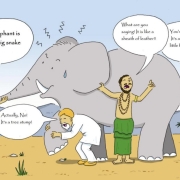Obesity is defined by the World Health Organization (WHO) as abnormal or excessive fat accumulation that may impair health. The American Medical Association (AMA) declared obesity to be a disease in 2013. As a result, increased research and funding are being directed towards obesity drugs, surgery, and counseling as well as for obesity-related diseases, such as type-2 diabetes and heart disease. Labeling obesity as a disease was also intended to decrease the stigma that comes from the widespread belief that obesity is just the outcome of excessive eating and not enough exercise.
A new study – F as in Fat: How Obesity Threatens America’s Future 2013– from the Robert Wood Johnson Foundation and Trust for America’s Health has recommended that there also be increased attention and funding directed at such initiatives as:
- Providing healthier food choices in schools
- Greater access to physical activity for children and adults
- Having restaurants post caloric information on their menus
- Food and beverage companies marketing only healthy choices to children
- A greater investment in health and the prevention of disease
- Increased availability of healthy and affordable food choices for all
Body Mass Index (BMI) is currently the common measurement for obesity. It is calculated as a person’s weight in kilograms divided by the square of their height in meters. This is a crude and misleading measurement at best as it defines the consequences of obesity rather than its causes. BMI is intended to indicate whether someone’s body weight is normal or not as follows:
- If your BMI is less than 18.5, it falls within the underweight range.
- If your BMI is 18.5 to <25, it falls within the normal.
- If your BMI is 25.0 to <30, it falls within the overweight range.
- If your BMI is 30.0 or higher, it falls within the obese range.
What is commonly referred to as morbid obesity is a BMI of over 40.0. Thirty years ago, 1.4% of Americans were morbidly obese, compared to 6.3% today – a rise of 350%.
The United States now has the second highest national level of obesity according to a report by the United Nations Food and Agricultural Organization. In that report, published in July 2013, Mexico’s adult obesity rate of 32.8% was just above America’s 31.8%. Why are so many Americans obese?
Obesity is a chronic disease affecting 95 million Americans – that’s one in three of us. That’s more than three times the number of adults with diabetes. Yet, there remains difficulty in accurately defining the condition, its root causes, and the many ways that it affects our lives. It is not merely a physical manifestation but can be a debilitating social and emotional challenge as well. There is a pervasive misconception that a person is obese solely because they eat too much and exercise too little. In reality the situation is much more complex than that. Aside from genetic and individual variations in our body’s ability to metabolize food, surely our culture and the food industry play significant parts as well.
When we look at obesity within the context of our social and cultural norms, several relevant observations can be made:
- Food manufacturers give a greater priority to pleasing our palate than to fueling our bodies. Grocery store shelves and marketing campaigns are filled with foods loaded with sugar, salt, fat, and carbohydrates.
- Snack foods and desserts have become our go-to foods for parties and celebrations, “treating ourselves,” and pushing down negative feelings.
- Restaurant portion sizes are typically much larger than what is considered to be a healthy serving.
- While the diet industry offers all sorts of diet programs, none have proven to result in long-term success for the obese. The average estimate is that 95% of diets fail.
- We have learned to choose fast foods rather than living at a pace that allows time to prepare and eat more nutritious meals.
- Those who are obese find it difficult not only to fit into restaurant booths and airplane seats but to be socially and professionally accepted on a par with the non-obese as well.
Notice how you think about and behave towards obese people. Where judgment comes naturally, try compassion. It’s not easy being fat in a world that caters to the thin. Help break the stigma of obesity by recognizing that there are many contributing factors beyond a simple equation of calories in and out.
In Part Two, I will share my personal journey through the world of obesity and how I found the answers that work for me.














